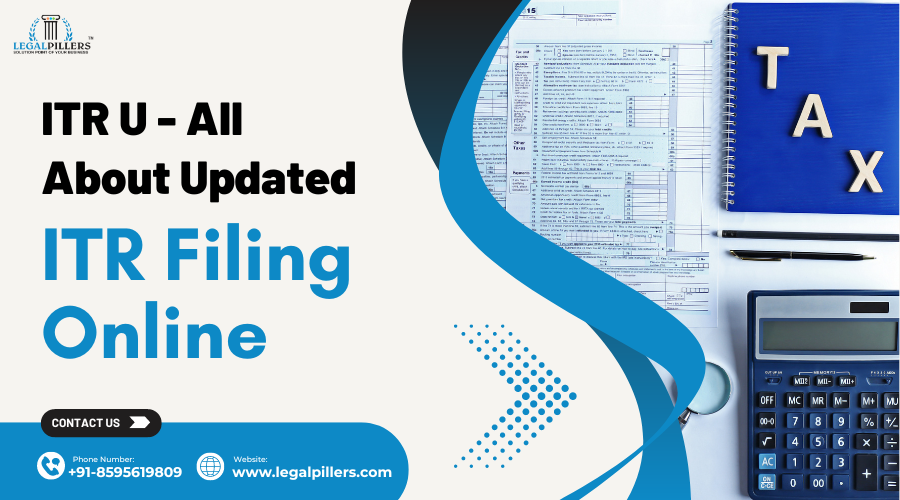
In India, filing Income Tax Return is a crucial responsibility of the taxpayers. It will not just make sure that you stay compliant with tax laws but also help in the development of the nation with their contributions to the revenues of the Government. But sometimes taxpayers make mistakes in online ITR Filing or may miss out on the Income Tax Return last date due some unavoidable circumstances. To cope with these situations, the Government has introduced the concept of updated Return.
Let’s have a quick glimpse at the concept of Income Tax, Income Tax Return, and Income Tax Return Filing!
- Income Tax is the direct tax that the public has paid to the Government of India every year. The income tax has been imposed by CBDT, i.e., Central Board of Direct Taxes, on individuals in India.
- Income tax Returns are a self-declaration form that the public uses to declare income.
- ITR Filing is the process by which taxpayers can report their income, deductions, and credits to the Government. Tax authorities use this information to calculate the amount of tax payable or the refund due.
Table of Contents
What is ITR–U?
ITR-U stands for the updated Income Tax Return. The concept of ITR-U has been introduced by India’s Income Tax department, allowing taxpayers to update their previously filed Income Tax Returns. ITR-U is an opportunity for taxpayers to rectify any error or mistake in the original Return, as well as to file the Return if they missed the original due date due to some inescapable circumstances.
Who Are Eligible for Updated ITR Filing Online (ITR-U)?
Taxpayers can file the updated Income Tax Return under section 139(8A). The taxpayers who have filed the original ITR, belated Return, or revised Return can file an updated Income tax Return. You can file the updated Return in the following cases-
- If you missed the deadline for original ITR Filing and belated return filing.
- When income has not been reported correctly.
- If you choose the wrong head of income.
- When you paid taxes at the wrong rates by mistake.
- In order to reduce the carried forward losses
- For the reduction of the unabsorbed depreciation
- In order to reduce the tax credit under section 115JB/ 115JC.
To get a clear picture of the eligibility criteria for filing ITR-U, you can seek the expert guidance of ITR Filing Consultants like Legal Pillers.
Who Are not Eligible for Updated ITR Filing Online (ITR-U)?
The taxpayer cannot file the updated Income Tax Return under some circumstances. Such cases are as given below-
- When you have already filed the updated Return.
- In order to file nil return/ loss return
- To claim/ enhance the refund amount
- An updated return reduces the tax liability.
- If a search under section 132 has been commenced against you
- If a survey under section 133A has been conducted
- When books of accounts, assets, or any other documents have been seized by the Income Tax Department.
- If any formality of assessment, reassessment, revision, or re-computation has been pending or completed for the specific year.
- When your tax liability has been adjusted with TDS credit/ losses, you don’t have any additional tax liability.
- If the assessment offices have information against the taxpayer regarding the Prevention of Money Laundering Act, Black Money Tax Act, Benami Property Transactions Act, or Smugglers and Foreign Exchange Manipulation Act, and the same has been reported to the assessee.
Updated ITR Filing Last Date
The time limit to file ITR-U is 24 months from the end of the specific assessment year. The income tax return’s last date to file ITR-U is as given below-
|
Financial Year (FY) and Assessment Year (AY) |
Last Date to File ITR-U |
|
FY 2021-22 (AY 2022-23) |
March 31st, 2025 |
|
FY 2022-23 (AY 2023-24) |
March 31st, 2026 |
| FY 2023-24 (AY 2024-25) |
March 31st, 2027 |
Additional Tax during Updated ITR Filing Online
Taxpayers who file updated Income Tax Return have to pay an additional tax of either 25% or 50% as per the period of filing the updated Return-
- If you file your updated Income Tax Return within 12 months from the end of the relevant Assessment Year (AY), then you have to pay an additional tax of 25% along with interest.
- If you file your updated income tax return within 24 months from the end of the relevant assessment year (AY), then you have to pay an additional 50% tax along with interest.
Format of ITR–U for Updated ITR Filing Online
ITR–U mainly consists of two parts, part A and part B.
PART A: General Information
This part comprises the taxpayers’ basic information. Sections (points) included in this part are as given below-
- PAN Number
- Name of the Taxpayer
- Aadhaar Number
- Assessment Year (for which ITR – U has been filed)
- The Return previously filed for this assessment year?
- If yes, Whether Filed u/s 139 (1) or others
- If applicable, enter the filed form, Acknowledgement no. or Receipt No. and Date of Filing the original Return (DD/MM/YYYY)
- Are you eligible to file an updated Return as per the conditions laid out in the first, second, and third provisions of section 139(8A)? (Yes/No)
- Please choose the ITR form from the drop-down to update your income.
- Select the reason for filing the ITR-U.
- Are you filing ITR-U during the period of up to 12 months from the end of the relevant AY or between 12-24 months from the end of the relevant AY
- Are you filing the updated Return to reduce carried forward loss or unabsorbed depreciation or tax credit? (Yes/No)
These are points included in Part A of ITR-U. You have to fill them out carefully.
PART B: ATI Computation of Total Updated Income and Tax Payable
- (A) Head of Income under which additional income is being Return as per updated Return
- (B) Total Income as per last valid Return (only in cases where the Income Tax Return has previously been filed)
- Total Income as per Part B-TI
- The amount payable, if any (To be taken from the – Amount payable of Part B-TT of the updated Return)
- Amount refundable, if any (To be taken from the – Refund of Part B-TT of the updated Return)
- The amount payable on the basis of the last valid Return (only in applicable cases)
- (i) Refund claimed as per last valid Return, if any (Please see instructions)
- (ii) total refund issued as per last valid Return, if any (including interest u/s 244A received
- Fee for default in furnishing return of income u/s 234F
- Regular Assessment Tax, if any
- Aggregate liability on additional income
- Additional Income Tax liability on updated income (25%-50% of (9-7)
- Net amount payable (9+10)
- Tax paid u/s 140B
- Tax Due (11-12)
- Tax payments (only as per updated Return)
These are the sections include in Part B of updated Return. Fill them carefully in order to avoid any issues in the future.
Process of Updated ITR Filing Online (ITR – U)
The process of filing an updated Return is simple and straightforward. The taxpayers who want to file ITR-U need to follow the given steps. The steps are-
- Step 1: Login to the e-Filing Portal
First of all, you have to logging into the e-filing portal of the income tax department with the help of your login credentials.
- Step 2: Select the option of ITR-U
After that, you have to navigate the e-file menu, then select the “Income Tax Return” tab and finally choose the option of ITR-U (updated Return)
- Step 3: Select the Relevant Assessment Year
Then, you have to choose the relevant Assessment Year (AY) for which you want to file the updated Income Tax Return.
- Step 4: Fill the Details
After that, you have to carefully fill in all the necessary details, including personal details, income, deductions, and tax payments. Also correct the errors or mistakes from your original ITR.
- Step 5: Calculate Tax and Pay Dues
Then, the portal will automatically calculate the additional tax payable as per the updated information. You have to pay the computed tax along with the applicable interest and penalties.
- Step 6: Submit the Updated Return
At last, after the successful verification of all the details in ITR-U you have to submit your updated Return. After submission you will get an acknowledgement receipt that you can download and save for the future reference.
These are the simple steps that you need to follow if you want to file your updated Return. Follow these steps carefully and fulfill your tax compliance.
How to Verify Updated Income Tax Return?
You can verify your updated Return via three different manners, which are as given below-
- Aadhaar OTP
- EVC, i.e. Electronic Verification Code
- DSC, i.e. Digital Signature Certificate
In the case of Tax Audit
- Via DSC, i.e. Digital Signature Certificate
Final Words
It is a crucial step for the Income Tax Department of India to introduce the concept of updated ITR Filing online. It provides the opportunity to correct their returns to the taxpayers. Filing an updated return is a responsible and beneficial action for any taxpayers who made any mistake or error in their original return or missed the deadline for filing the ITR. It will help in maintaining compliance, avoiding penalties, and making sure about the peace of mind. If you have any confusion regarding whether you need to file ITR – U or not, you should have to take expert guidance from ITR Filing Consultants like Legal Pillers. Legal Pillers has a dedicated team of professionals that help you throughout the process of filing ITR – U, from providing guidance about the eligibility criteria of ITR – U to filing your updated Return effortlessly. So, what are you waiting for? Contact Legal Pillers now and fulfil your tax compliances seamlessly.
Other Related Blogs
- ITR Filing Online for FY 2023-24
- Step-by-step guide for ITR Fling Online
- How can Tax Planning save you from huge losses
- ITR 1 Filing
- ITR 2 Filing
- ITR 3 Filing
- ITR 4 Filing
- Filing ITR 5
- Filing ITR 6
- Filing ITR 7
- Chartered Accountant Near Me for Tax Filing
- What is the Importance of Income Tax Return Filing?
- Where Can I Find Income Tax Return Filing Near Me?
- Tax Slabs and Rates for Online ITR Filing For FY 2023-24
- What Happens If I Don’t File Income Tax Return?
- What is the Income Tax Return Last Date for FY 2023-24 (AY 2024-25)?
- HUF Online ITR Filing: Tax Benefits for HUFs
- How to Save Tax for a Pvt Ltd Company While ITR Filing Online?
- Steps to Register DSC on the Portal of Online ITR Filing
- How to File ITR Online in Delhi?
- Understanding Belated & Revised Income Tax Return Filing
- ITR Filing for Sole Proprietorship



Leave a Reply